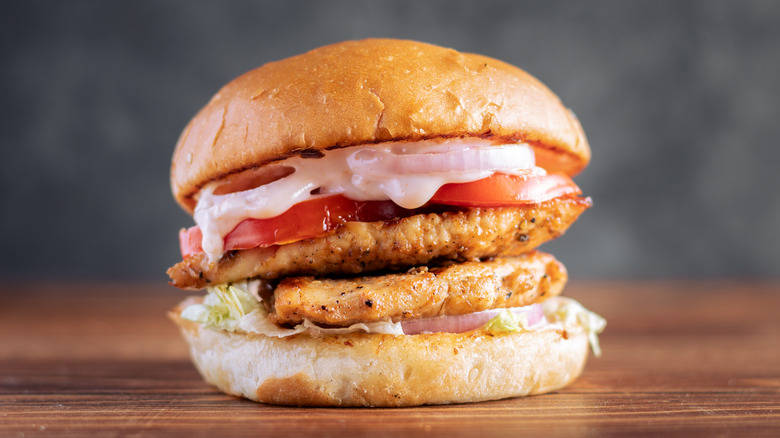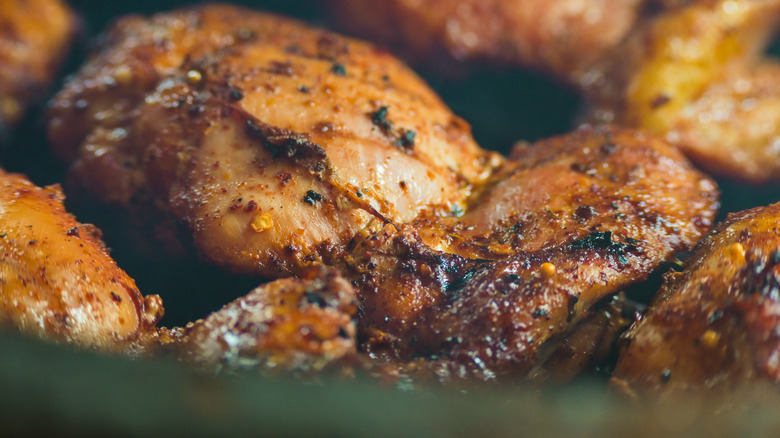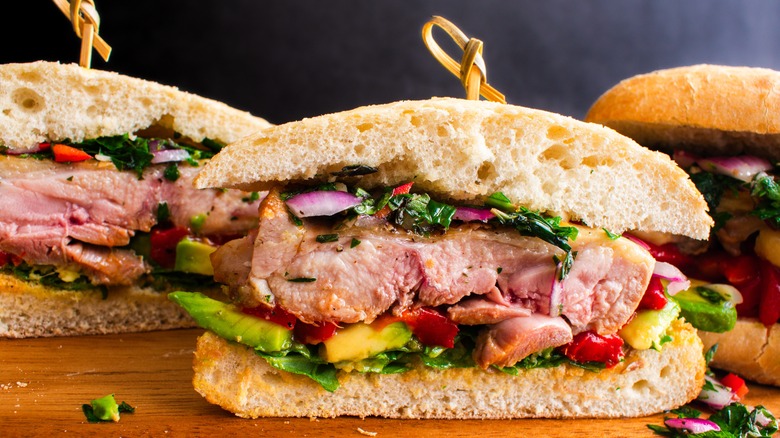Chicken Breast Vs Thigh: Which Is Best For A Grilled Chicken Sandwich?
Quite often, chicken breasts go on grilled chicken sandwiches in the United States. After all, when it comes to food that used to cluck, white meat has been more popular in the U.S. than dark meat for the last several decades, starting around the time supermarkets began selling chicken pieces (e.g., breasts, thighs, and wings) instead of only whole birds. This, combined with the rampant fear of dietary fat in the 1980s and '90s, led to a general preference for lighter, so-called "healthier" meats, and chicken breast came out the winner. While thigh meat has become more popular with time, there's still the unspoken assumption that the breast is inherently the best cut of the bird, and the one most deserving of a spot on a grilled chicken sandwich.
The problem with this is that it's simply not true — at least, not necessarily. We have no bone to pick with chicken breasts. What we do have is a major love for chicken thighs, and a desire to see this underdog cut get the appreciation it deserves for its culinary, health, and economic benefits. Its flavor is beaks and shoulders above that of breast meat, it's foolproof to cook, generally more budget-friendly than breast meat, and it's not as unhealthy as its detractors of the previous decades led us to think. For all these reasons and more, chicken thighs merit strong consideration for your next grilled chicken sandwich.
Why chicken thighs are better for a grilled chicken sandwich
From a flavor perspective, thighs win wings-down for chicken sandwiches. The dark meat offers a delectably rich, savory experience compared to the milder flavor of chicken breasts. Your taste buds can get very busy when you've added all the best toppings to your chicken sandwich, so you'll appreciate a protein that can keep itself front and center, and not be diminished by the variety of other flavors.
Another benefit of chicken thighs is that they're nearly impossible to overcook. Extremely forgiving, they stay juicy and tender no matter what you do to them. A great temp for thighs is 175 degrees Fahrenheit, but 185 degrees is even better, and 195 even better yet. In contrast, unless you've perfected the art of not overcooking chicken breasts, they're notoriously easy to dry out due to their lack of fat. Thus, for a more stress-free grilling experience, thighs are where it's at.
Let's touch on the health perspective, since that was what gave chicken breasts their reputation for superiority in the first place. One hundred grams of boneless, skinless cooked chicken thigh contains 179 calories and 8.2 grams of fat, only slightly more than the same quantity of cooked chicken breast at 165 calories and 3.6 grams of fat. The best choice ultimately depends on individual dietary needs and preferences, but thighs are by no means the heart-attack-in-waiting that doctors presented them as in yesteryears.
How to prepare chicken thighs for a grilled chicken sandwich
First off, go for boneless, skinless chicken thighs; these will be quicker and easier to prepare for a sandwich. The dark meat's flavor will already be intense and rich, but you might prefer to enhance it even more. In this case, rubs or marinades are a great way to add more flavor to grilled chicken. Just remove the thighs from the marinade before four hours if you're using an acidic ingredient such as lemon juice. This will ensure the meat's texture maintains its consistency.
Get your grill good and hot — about 400 to 450 degrees Fahrenheit is ideal — and cook the thighs over direct heat. (If we were grilling skin-on, we'd go for indirect heat.) Flip them once, about halfway through cooking.
How long it takes the thighs to reach the minimum internal temperature of 165 degrees Fahrenheit depends on how thick they are and how efficient your grill is, but you can typically expect them to hit this temp at around eight to 10 minutes. To test for doneness, use a meat thermometer inserted into the thickest part of the thigh. Remember: You're aiming for that juicy 175 to 195 degrees Fahrenheit, so adjust your cooking time accordingly once the minimum is reached.


